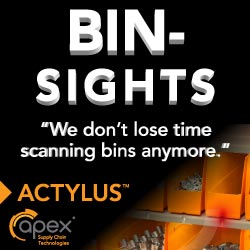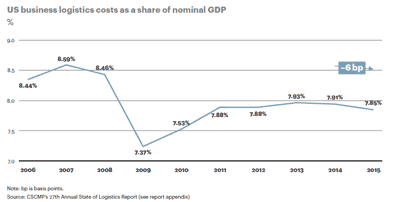 |
June 23, 2016 - Supply Chain Flagship Newsletter |
 |
| FEATURED SPONSOR: APEX SUPPLY CHAIN TECHNOLOGIES |
|||
 |
|||
Download the Complimentary Case Study: |
|||
 |
|
|||||||||||||||||||||||||||||||||||||||||||||||||||||||||||||||||||||||||||||||||||||||||||||||||||||||
|
||||||||||||||||||||||||||||||||||||||||||||||||||||||||||||||||||||||||||||||||||||||||||||||||||||||||
This represents the 27th edition of the report, which was launched in 1988 by the late Bob Delaney and sponsored by his company, Cass Information Systems. Somewhere along the way, CSCMP took over the sponsorship, and in the late 1990s Rosalyn Wilson, who has a long career in the logistics industry, began to support Delaney in his efforts. Upon Delaney's passing a few years later, Wilson took on the challenge alone, largely keeping the existing methodology, heading the report until Kearney took on the job for 2016. So, simple to say, harder to calculate, you take the number for US logistics costs and divide it by annual nominal GDP numbers and voila, logistics costs as a percent of GDP emerges. The methodology must use nominal GDP as the denominator because the costs for the year are compiled in nominal terms. The growth in USBLC, however, slowed to just 2.6% in 2015, with transportation costs - the largest single component of USBLC - up by only 1.4% in 2015.That transport cost decline was caused by a combination of lower oil prices (down some 30% over the year), which decreased fuel surcharge expenses sharply across all modes, and softness in freight volumes across all modes except parcel. The total cost of US logistics was estimated at $1.408 trillion for 2015, up $30 billion or so in 2014 under the new calculation. A lot of elements go into that number, from warehouses to trucking to pipelines, but the three main categories are inventory carrying costs, including the costs of warehousing (30.3% of the total logistics spend in 2015), transportation costs (63.2%), and administrative costs, mostly related to spend on freight forwarders and logistics IT spend not otherwise captured in the other two categories (just 6.4% of the total). Within transportation, trucking-related spend (including private fleets but excluding parcel) comprise 65.4% of total transport costs and 41.3% of total logistics spend. Parcel was broken out for the first time this year as a separate cost category, estimated at $82.2 billion in total, or 9.2% of transport costs and 5.8% of total logistics. Any reaction to our summary of this year's State of Logistics Report? Do you like the new style? How could it be improved? Let us know your thoughts at the Feedback section below. |
||||||||||||||||||||||||||||||||||||||||||||||||||||||||||||||||||||||||||||||||||||||||||||||||||||||||
|
||||||||||||||||||||||||||||||||||||||||||||||||||||||||||||||||||||||||||||||||||||||||||||||||||||||||
|
||||||||||||||||||||||||||||||||||||||||||||||||||||||||||||||||||||||||||||||||||||||||||||||||||||||||
|
|
|
YOUR FEEDBACK
Ok, our last set of some of the many emails we received on our coverage of Lessons from Finish Line's Distribution Disaster. Many great responses.
Feedback on Lessons from Finish Line's Distribution Disaster:
Mark Shuda |
||
I noted the consultant, you first referenced, called out the issue of "buy-in" from the company personnel who would be responsible to implement and operate the new facility and systems. To put it simply - BINGO! As a retired supply chain executive and consultant, I can tell you our most significant challenge every single time we were standing up a new facility and system for a client was the full buy-in of the company personnel (from CEO to Order Picker in the warehouse) to the new program. Supporting that buy-in had to be adequate funding, a detailed implementation plan with a reasonable schedule and accountability assigned plus the development of a comprehensive training plan for all (throughout the company) with close monitoring and mentoring before, during and after startup. These were essential elements of a successful project. If we could not get that understanding with a client, we walked away. James Nelson |
||
Wow, lots of painful and happy memories from earlier in my career when I did hundreds of these systems implementations. Regarding the comment of Tompkin’s Kevin Hume on WMS/DOM implementation. The fact that Finish Line was implementing DOM suggests that they have multiple DC’s. DOM is a overlay concept to manage customer order distribution across multiple distribution points, and in my opinion should not be implemented until the DCs are running correctly. Plan and lay the groundwork for DOM as part of the WMS, but do the WMS first. Sound like FL went "big bang" across the full business. I would have chosen 1-2 pilot locations to prove the WMS before going big. Pilots should have been first in a smaller DC which could easily be controlled and less impactful if there were failures, then a larger DC to prove scale – both would provide valuable learning experience and tools, and the opportunity to work out the kinks before bringing the business to its knees. Having a sound WMS running in one-two facilities will help "sell" the value of the system to others (convincing folks to change is always a bugger). Steven R. Murray Supply Chain Visions
|
||
| I was lucky enough to not be part of FinishLine project (yes, I can say that again! I have not heard horror stories from those who were on the project, but none of them wanted to stay on it for long).
I have been on several projects that do it all wrong to start with. At times, it is a company's own employees (on functional side) or sometimes it is IT team , and in many instances, it is the System Integrator or the Software Vendor at fault - and in the ones where distastes are biggest, it is a typically a joint effort. Since I am typically on the Software Vendor side, here is what I have seen in close quarters: 1. Consulting Managers typically are afraid to give bad news to client. 2. They keep harping on their own team of consultants to get it right (no matter who may be wrong and how hard the consultants try, they can't get it right because of other variables on the project). 3. After a certain point (go live is pushed 4 times, and if the Software Vendor is not making any money - typically fixed fee projects in today's world) - every one starts cutting corners - take knowledgeable resources to profit making projects, put newbies in. 4. Vendors stop proposing changes to the project - which may bring right functionality, because they know that client is not ready to pay for it and if they propose it, it may have to do it for free. Chirag Sanghavi |
SUPPLY CHAIN TRIVIA ANSWER
Q: What percent of growth in global energy consumption in 2015 came from emerging economies?
A: Astoundingly, 97%, led by China and India, according to the Statistical Review of World Energy 2016 just released as usual by BP. OECD country consumption saw only a slight rise.
| © SupplyChainDigest™ 2003-2016. All Rights Reserved. SupplyChainDigest PO Box 714 Springboro, Ohio 45066 |
POWERED BY: XDIMENSION
|









